The Role of Endogenous Retroviruses in Placental Gene Expression
By Anna Harnsberger
Introduction
The role of integrated or “endogenous” retroviruses (ERVs) is extensive. ERVs contribute both positively and negatively toward the health of humans and other taxonomic groups. The functionality of these viruses relies heavily on the process of retrotransposition. This process involves the reverse-transcription of the retrovirus genome into the DNA of the host cell. Though some ERVs are detrimental to human health, such as HIV-1, others are “domesticated” and do not pose a threat.[1] Domesticated ERVs, likely inactivated by mutations over millions of years, serve in adaptive functions of the host. [2] Specifically, the presence of ERVs is essential during human pregnancy. The placenta, a vital organ developed during gestation, is affected by the presence of ERVs. ERVs, acting as non-coding regulatory elements, are key contributors to placental evolution. Absence or mis-expression of specific ERVs in the placenta during pregnancy, results in pre- and or post- defects such as pre-eclampsia (PE). Despite what is known about the importance of ERVs in placental gene expression, there is still much research to be done to fully understand the impacts of these retroviruses on the placenta.
The Role of Endogenous Viruses in the Placenta
ERVs are an essential component of the development of the placenta, not only for humans but a vast array of animals. The origin of ERVs into the placenta is understood to have occured approximately 100 million years ago (Myr). ERVs parasitized living species even before the viruses began to appear in mammals.[3] As opposed to exogenous viruses which are associated with infection, ERVs are germ-line integrated into the host DNA by vertical gene transfer.[4] ERVs evolve more slowly than their exogenous counterparts and function in a sort of symbiosis with their host, given their normal presence in the genome. The importance of ERVs in the placenta focuses on specific envelope genes that originate from the retrovirus, these will be covered in depth in the following sections. The core components to consider when understanding the importance of ERVs is their role in cell differentiation, cell fusion and their immunosuppressive properties.
Placental & Endogenous Retrovirus Structural Components
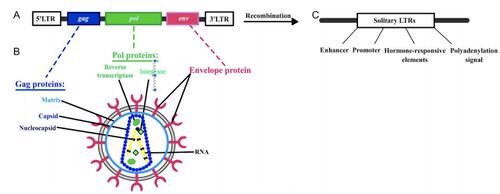
The presence of ERVs in host genomes is the result of either direct insertion by host homologous end joining, or from transposition through the use of retrotransposons.[3] Approximately 8% of the human genome consists of endogenous retroviral elements.[6] Although exogenous retroviruses and ERVs have different impacts on the human body, they share the same structure which consists of four viral genes: gag, pro, pol and env, flanked by two long terminal repeats (Figure 1). Gag genes encode for major viral structural proteins; pro and pol encode for viral enzymatic machinery and env encodes for the envelope glycoprotein. The envelope glycoprotein embeds into the lipid bilayer of the exterior membrane in order to form the viral envelope and controls the entry of viruses into susceptible cells.[7] These components of the envelope protein are significant in the way which ERV evolution occurred in mammals and the way in which envelope genes can affect the different functional components of mechanisms within the placenta. The placenta itself has several key structural components which are important to understand.
Nomenclature to understand with respect to this topic includes the placental tissue, also known as the trophoblast, composed of peripheral cells of the blastocyst. The blastocyst is a specific stage of the mammalian embryo, with a composition similar to that of a hollow cell ball. Furthermore, cytotrophoblasts are important for attachment to the inner uterine wall. These cells are important for cell-cell fusion along with myoblasts, macrophages, and gametes. Most notably, cytotrophoblasts are important in formation of syncytiotrophoblasts. Syncytiotrophoblasts aid in mediating implantation of the embryo into the maternal endometrium as well as functions of exchange related to the mother and fetus, regulatory immune response, protection against pathogens and hormone secretions.[3] The terminology related to placental development is necessary to understand, with respect to how ERVs affect the organ.
The Surface and Transmembrane Subunits

The different components of the retroviral envelope consists of the surface (SU) and transmembrane (TM) subunits as well as the immunosuppressive domain (ISD).[3] The env gene of retroviruses encodes for a protein which is cleaved by a cellular protease in order to produce the TM and SU subunits. The SU subunit has a domain which interacts with a receptor on the surface of cells that is only susceptible with the virus. The TM subunit is responsible for triggering the fusion of the virus and cell membranes by insertion of its N-terminal fusion peptide into the cell membrane.[3] These subunits remain as a heterodimer at the surface of the virion envelope membrane (Figure 2). The role of these subunits is important with respect to the immunosuppressive activity of the Syncytin-2 protein.
The Evolutionary Diversification of the Placenta
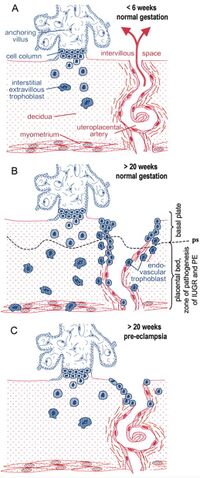
Despite the emergence of ERVs in the placenta after the evolution of mammals, there are multiple factors which lead to differentiation of the placenta amongst these different species. Including diversity of the cytotrophoblasts, syncytiotrophoblasts and the degree of invasiveness of trophoblasts. Amongst different species, there is variation of the types of placental interface. There is an increase of invasive trophoblasts from synepitheliochorial (ruminants), endothelialcorial (carnivores), and hemochorial (mice, rabbits, humans). Trophoblast invasion is important in all of these species, since malinvasion can result in PE or Intrauterine Growth Retardation (IUGR)(Figure 3).[8]
Synctins: Key Proteins Originating from Endogenous Retroviruses
When considering the role of ERVs on the development and regulation of the placenta, the key proteins that should be considered are “Synctins". Synctins are cellular proteins which correspond to functional ERV env open reading frames as single copies, which have been conserved throughout evolution.[9] Syncytin proteins play an important role in cell-cell fusogenic activity and immunosuppression of the envelope proteins. [3]
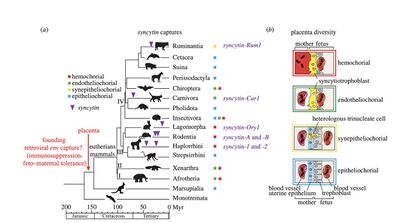
There are two notable types of Syncytin proteins found in the human placenta, encoded by env genes HERV-W (Syncytin-1) and HERV-FRD (Syncytin-2). Syncytin-1 is a glycoprotein, with cell fusogenic activity, promoting the fusion of cytotrophoblast cells in order to form the multinucleated syncytiotrophoblast layer. Syncytin-2 is associated in its role of immunosuppression.[5] The membrane receptor for Syncytin-1 is ASCT-2 and ASCT-1 and the phospholipid transporter MFSD-2 for Syncytin-2.[9] The functionality of these two genes has been conserved in evolution since their first insertion into the primate genome, approximately 25-40 Myr, Syncytin-2 is the more ancient of the two genes. Both genes have little polymorphism and therefore show signs of purifying selection or stabilizing selection. [3] Analogous to the human “Syncytin-1” is the murine gene “Synctin-A”, the human “Synctin-2” gene is analogous to the murine “Synctin-B” gene. It is important to note that although the murine and human Syncytin proteins are similar in their functions, they are homologous but not orthologous(Figure 4).[3]
Fusogenicity of Syncytin-A and Syncytin-1
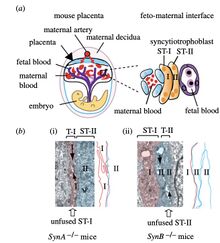
Given the likeness of the murine Syncytin proteins with those of humans, murine have been a beneficial model for determining the role that Syncytin proteins play in placental development. It has been found that using the mouse model, that Synctin-B and Gcm1 (the placental transcription factor) genes are both expressed in the ST-II layer, one of the two distinct layers of syncytiotrophoblasts within mice. [3] The two ST-layers arise from the fusion of trophoblast cells during the “labyrinth formation”(Figure 5).[3] The labyrinth is the interface for nutrient and other gas exchange between the embryo and mother.[10] The ST-II layer contains an abundance of lipids which are tightly adhered to one another through gap junctions available for intracellular transport.[11]
Syncytin-A was found to be expressed in the other layer, ST-I. Using knock-out gene expression, it was found that loss of Syncytin-A gene in mice was detrimental, homozygous mutant embryos died mid-gestation. This demonstrates that lack of Syncytin-A mediated trophoblast cell-fusion results in cell overexpansion affecting the fetal blood vessel spaces due to apoptosis, and leads to defects of the maternal-fetal interface structure causing decreased vascularization and inhibition of placental transport.[11] Absence of Syncytin-A ultimately results in the death of the embryo. Thus, it can be conferred that much like Syncytin-A, Syncytin-1 is vital to embryo survival (Figure 6). This study highlights that a gene of retroviral origin is necessary for found physiological processes of the placenta.[10]

Furthermore, researchers found that both homotypic and heterotypic fusion were promoted via the expression of HERV-W in placenta specific cells. With respect to homotypic fusion, cell-cell fusion assays which were transiently expressed in parental TE671 human cells resulted in an abundance of syncytia.[12] Heterotypic fusion was demonstrated by cocultivating TE671 Env-transfected cells with HeLa indicator cells. Post 48 hours, up to 48 % of the coculture had distributed into large syncytia. In comparison, expression of A-Rless (a mouse leukemia virus) resulted in fusion of only ~6% of the cultured cells. These findings support that Syncytin-1 protein, which results from expression of HERV-W, is a highly fusogenic membrane protein. However, it is important to note that the fusogenic property of this HERV-W expressed protein depends on the interaction with specific cell surface receptors.[12]
Immunosuppression of Syncytin-B and Syncytin-2
In contrast to the role of the Syncytin-1 protein of cell-cell fusion , Syncytin-2 has immunosuppressive properties that are encoded by retroviral envelope sequences. Though Syncytin-2 aids in the fusion of the placental trophoblasts as well as the formation of multinucleated syncytiotrophoblast, it has been found to play a more prominent role in immunosuppression.[13] Researchers, have focused on the ISD of the Syncytin-B protein using deletion analysis of immunosuppressive and non immunosuppressive sequences to discover the mutation of amino acids which causes the switch from immunosuppressive to the non immunosuppressive envelope protein.[14] Researchers used in vivo tumor rejection-assays to demonstrate the IS activity of env proteins in which expression of the immunosuppressive Syncytin protein enabled the temporary engraftment of allogeneic tumor cells. Furthermore, IS activity of Syncytin-2 was further examined in another in vivo assay that used recombinant env subdomains, primarily ectodomains (domain of a membrane protein extending outside the cell) to demonstrate enhanced antibody response against the env protein after inhibition of the ISD function.[14] IS activity of the Syncytin-2 is essential for development of the fetus, its IS activity is likely most necessary for protecting the developing fetus from the surveillance of the maternal immune system.[15]
Function of env ERV- 3 Protein
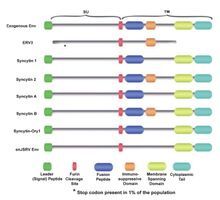
In addition to HERV-W and and HERV-FRD, a third ERV, Erv-3, is an important gene related to the role of ERVs present in the placenta. With respect to structure, Env-3 has a long open reading frame, it is unique in that it has a premature stop codon which inhibits its ability to anchor to the cell membrane. Furthermore, Erv-3 lacks a leader and fusion peptide (Figure 7).[7] Researchers have used BeWo cells (from a choriocarcinoma) to model trophoblast differentiation. In one study, the expression of Erv-3 mRNA was observed over a span of 96 hours with treatment of forskolin in order to identify how this gene functions in comparison to the prominent genes (HERV-W and HERV-FRD) which code for Syncytin proteins. In a separate test, researchers constructed expression vectors containing either the sense strand of the Erv-3 env open reading frame or only the plasmid.
It was found that BeWo cells that contained the vector, had significant depression of cell growth (detected using 3H-tdR). BeWo transfected with just the plasmid had no evident morphological changes.[16]
In both the study using the forskolin induced cells and the vector containing the Erv-3 env open reading frame, there was increased production of β-hCG (a hormonal differential marker for trophoblasts). Furthermore, Erv-3 env was expressed in undifferentiated BeWo cells, inducing changes similar to those of trophoblast differentiation. Thus it was thought that env protein Env-3 had a greater role in cell differentiation rather than cell-cell fusion.[16] However, 1 % of caucasian individuals have the previously mentioned premature stop codon in the Erv-3 gene, rendering the protein non-functional. [7] Thus, the env protein Env-3 serves as a good example in the way which ERVs have evolved to be mutationally disabled within the normal tissues of humans, specifically in reproductive organs.
Supplemental: Placental Immunomodulatory Defense Against SARS-CoV-2
Severe acute respiratory syndrome virus 2 (SARS-CoV-2) coronavirus, is the cause of the COVID-19 pandemic. This virus originally spread throughout Wuhan, China and has continued to infect individuals nationwide. For the most part, it has become apparent that individuals with underlying health factors such as asthma, obesity, diabetes, etc. are considered to be “at-risk” groups for this infection. However, one of the unknowns for the infection of this virus is its affect and pathway of infection to the fetus of Covid-19 positive mothers. There is much research that has to be accomplished to consider the risk of the infection on the placenta at the molecular level. Outlined below are key concepts to consider with respect to how the SARS-CoV-2 coronavirus and viruses with similar mechanisms, target the maternal-fetal barrier.
Defenses of the Placenta Against Pathogens
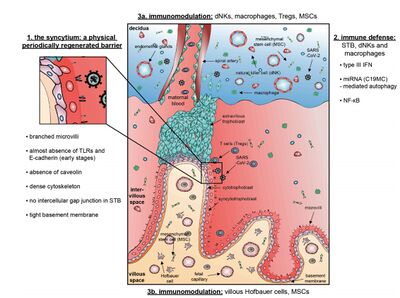
With respect to the previous discussion of ERVs in the placenta, it is important to consider pathogenic retroviruses and how these compare with their structurally related "domesticated" ERV counterparts. Some retroviruses such as the lentivirus “HIV”, are detrimental to the host organism. Interestingly, HIV is similar to the SARS-CoV-2 virus in that viral RNA initially enters into the host cell via a nucleocapsid and must then be uncoated. [18] This is one example in which a pathogen is able to cross and infect the placental barrier through the maternal blood. In order to prevent entry of viruses, the placenta has a plethora of structural and immunomodulatory defense mechanisms. These defense mechanisms include: 1) the outermost syncytium (STB) layer (which does not contain gaps or junctions), 2) the STB layer which forms a dense cytoskeletal network creating a border for the apical surface, 3) pathogen receptors which are used for pathogen recognition (STB expresses toll-like receptors), 4) the STB does not express caveolins (involved in receptor-independent endocytosis), 5) the membrane below the villous cytotrophoblast (vCTB) layer acts as a physical barrier to prevent virus entry.[17] Three other major defense pathways against SARS-CoV-2 within the placenta include: 1) the Type III interferon (IFN) signaling (IFN has an antiviral response) , 2) secreted miRNAs which trigger autophagy (removal of unnecessary cells), and 3) Nuclear Factor Kappa B (NF-κB) (a transcription factor which evokes immune response)(Figure 8). [17] However, if a virus manages to enter through the placental barrier, the results may be miscarriage, stillbirth, fetal sepsis, death, etc. The question being pursued in current research is whether SARS-CoV-2 can undergo vertical gene transfer (similar to the way in which "domesticated" ERVs enter the genome) or if only horizontal transfer can occur from mother to newborn.
Structure of SARS-CoV-2
The key protein for entry of SARS-CoV-2 into a host cell is the S-protein, which binds to the human angiotensin-converting enzyme II (ACE2). In addition to the ACE2 receptor, other alternative receptors for the S-protein include: dipeptidyl peptidase 4 (DPP4) (SARS-CoV-2 can bind to this alternate receptor with high affinity), cluster of differentiation 147 (CD147)/Basigin (BSG) (facilitates viral invasion). In order for SAR-CoV-2 infection of the placenta, the placental cells must have the receptors mentioned above and proteases such as human transmembrane protease serine 2 (TMPRSS2) and cathepsin L (CTSL). [17]
Impact of SARS-CoV-2 on the Maternal-fetal Barrier and the Health of Newborns
Research surrounding the impact of SARS-CoV-2 on the placenta has focused on the localization of receptors such as ACE2 on the STB, vCTBs, the endothelium, vascular smooth muscle cells, and extravillous trophoblasts. Data from studies indicates that presence of both ACE2 and TMPRSS2 is necessary for SARS-CoV-2 entry into cells. Other studies examine levels of receptors such as CD147 to evaluate the impacts of the virus during pregnancy. As such, CD147 levels were found to be high in PE women. An increase in the stated levels of specific receptors and protease are thought to deteriorate the immune system of women with Covid-19 and thus render the placenta more susceptible to infection. [17]
In one study, researchers found that of 179 newborns, the infection rate was 4.47 % and eight of the cases were potentially a result of vertical transmission. [19] In addition to this study, another group of researchers found that in a review with 275 pregnant women with moderate SARS-CoV-2 symptoms, and 248 newborns, two stillbirths and 8% of the newborns tested positive for SARS-CoV-2 via RT-PCR testing. [20] However, it is still unclear whether these results were due to vertical transmission or the horizontal transmission of the virus to the child after delivery.
Despite the trends of the above information, it is important to understand that the vertical transmission of SARS-CoV-2 transmission is likely only to occur in rare occasions. In order to learn more of how this virus impacts the placenta there should be an increased application of animal models, placental explant cultures, trophoblastic cell lines and similar methods to enhance the understanding of this virus on the health of the maternal-fetal interface.[17]
Conclusion
Despite the unlikely origin of ERVs from once infectious viruses, these genes have become essential to the health of the mammalian placenta. Retroviruses, normal components of the genome, have amplification potential of up to ⅓ of the human genome. [4] The most prominent ERV env genes, encoding for the Syncytin proteins are an integral component of the wellness of the embryo during gestation. Furthermore, the different roles of the env proteins signify the diversification of the ERVs over the course of millions of years. These genes are necessary for the development of the placenta in order for the organ to be equipped with all necessary molecular components for normal functioning and in the case of 2019-2021, defenses against the SARS-CoV-2 virus.
Authored for BIOL 238 Microbiology, taught by Joan Slonczewski, 2021, Kenyon College.
- ↑ [Haig, D. (2012). Retroviruses and the placenta. Current Biology,22(15), R609-R613.]
- ↑ [Knox, K., & Baker, J. C. (2008). Genomic evolution of the placenta using co-option and duplication and divergence. Genome research, 18(5), 695-705. ]
- ↑ 3.00 3.01 3.02 3.03 3.04 3.05 3.06 3.07 3.08 3.09 3.10 3.11 3.12 [Lavialle, C., Cornelis, G., Dupressoir, A., Esnault, C., Heidmann, O., Vernochet, C., & Heidmann, T. (2013). Paleovirology of ‘syncytins’, retroviral env genes exapted for a role in placentation. Philosophical Transactions of the Royal Society B: Biological Sciences, 368(1626), 20120507. ]
- ↑ 4.0 4.1 [Harris J. R. (1998). Placental endogenous retrovirus (ERV): structural, functional, and evolutionary significance. BioEssays : news and reviews in molecular, cellular and developmental biology, 20(4), 307–316.]
- ↑ 5.0 5.1 [Soygur, B., & Sati, L. (2016). The role of Syncytin proteins in human reproduction and reproductive organ cancers, Reproduction, 152(5), R167-R178. Retrieved Apr 4, 2021, from https://rep.bioscientifica.com/view/journals/rep/152/5/R167.xml]
- ↑ [Griffiths, D. J. (2001). Endogenous retroviruses in the human genome sequence. Genome biology, 2(6), 1-5. ]
- ↑ 7.0 7.1 7.2 7.3 [Black, S. G., Arnaud, F., Palmarini, M., & Spencer, T. E. (2010). Endogenous retroviruses in trophoblast differentiation and placental development. American journal of reproductive immunology (New York, N.Y. : 1989), 64(4), 255–264. https://doi.org/10.1111/j.1600-0897.2010.00860.x ]
- ↑ 8.0 8.1 [Kaufmann, P., Black, S., & Huppertz, B. (2003). Endovascular trophoblast invasion: implications for the pathogenesis of intrauterine growth retardation and preeclampsia. Biology of reproduction, 69(1), 1-7. ]
- ↑ 9.0 9.1 [Coquin, Y., Ferrand, M., Seye, A., Menu, L., & Galy, A. (2019). Syncytins enable novel possibilities to transduce human or mouse primary B cells and to achieve well-tolerated in vivo gene transfer. bioRxiv, 816223. ]
- ↑ 10.0 10.1 [Tai-Nagara, I., Yoshikawa, Y., Numata, N., Ando, T., Okabe, K., Sugiura, Y., Ieda, M., Takakura, N., Nakagawa, O., Zhou, B., Okabayashi, K., Suematsu, M., Kitagawa, Y., Bastmeyer, M., Sato, K., Klein, R., Navankasattusas, S., Li, D. Y., Yamagishi, S., & Kubota, Y. (2017). Placental labyrinth formation in mice requires endothelial FLRT2/UNC5B signaling. Development (Cambridge, England), 144(13), 2392–2401.https://doi.org/10.1242/dev.149757]
- ↑ 11.0 11.1 11.2 [Dupressoir, A., Vernochet, C., Bawa, O., Harper, F., Pierron, G., Opolon, P., & Heidmann, T. (2009). Syncytin-A knockout mice demonstrate the critical role in placentation of a fusogenic, endogenous retrovirus-derived, envelope gene. Proceedings of the National Academy of Sciences, 106(29), 12127-12132. ]
- ↑ 12.0 12.1 [Blond, J. L., Lavillette, D., Cheynet, V., Bouton, O., Oriol, G., Chapel-Fernandes, S., ... & Cosset, F. L. (2000). An envelope glycoprotein of the human endogenous retrovirus HERV-W is expressed in the human placenta and fuses cells expressing the type D mammalian retrovirus receptor. Journal of virology, 74(7), 3321-3329.]
- ↑ [Toufaily, C., Lokossou, A. G., Vargas, A., Rassart, É., & Barbeau, B. (2015). A CRE/AP-1-like motif is essential for induced syncytin-2 expression and fusion in human trophoblast-like model. PloS one, 10(3), e0121468. ]
- ↑ 14.0 14.1 [Mangeney, M., Renard, M., Schlecht-Louf, G., Bouallaga, I., Heidmann, O., Letzelter, C., Richaud, A., Ducos, B., & Heidmann, T. (2007). Placental syncytins: Genetic disjunction between the fusogenic and immunosuppressive activity of retroviral envelope proteins. Proceedings of the National Academy of Sciences of the United States of America, 104(51), 20534–20539. https://doi.org/10.1073/pnas.0707873105 ]
- ↑ [Liang, C. Y., Wang, L. J., Chen, C. P., Chen, L. F., Chen, Y. H., & Chen, H. (2010). GCM1 regulation of the expression of syncytin 2 and its cognate receptor MFSD2A in human placenta. Biology of reproduction, 83(3), 387-395]
- ↑ 16.0 16.1 [Lin, L., Xu, B., & Rote, N. S. (1999). Expression of endogenous retrovirus ERV-3 induces differentiation in BeWo, a choriocarcinoma model of human placental trophoblast. Placenta, 20(1), 109-118. ]
- ↑ 17.0 17.1 17.2 17.3 17.4 17.5 [Kreis, N. N., Ritter, A., Louwen, F., & Yuan, J. (2020). A message from the human placenta: Structural and immunomodulatory defense against SARS-CoV-2. Cells, 9(8), 1777.https://doi.org/10.1002/(SICI)1521-1878(199804)20:4<307::AID-BIES7>3.0.CO;2-M]
- ↑ [Slonczewski, J., Foster, J., & Zinser, E. (2017). Microbiology (5th ed.). W.W. Norton and Company, Inc.]
- ↑ [Egloff, C., Vauloup-Fellous, C., Picone, O., Mandelbrot, L., & Roques, P. (2020). Evidence and possible mechanisms of rare maternal-fetal transmission of SARS-CoV-2. Journal of clinical virology : the official publication of the Pan American Society for Clinical Virology, 128, 104447.https://doi.org/10.1016/j.jcv.2020.104447]
- ↑ [Trippella, G., Ciarcià, M., Ferrari, M., Buzzatti, C., Maccora, I., Azzari, C., Dani, C., Galli, L., & Chiappini, E. (2020). COVID-19 in Pregnant Women and Neonates: A Systematic Review of the Literature with Quality Assessment of the Studies. Pathogens (Basel, Switzerland), 9(6), 485.]
